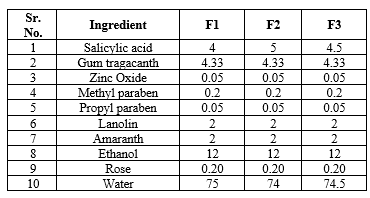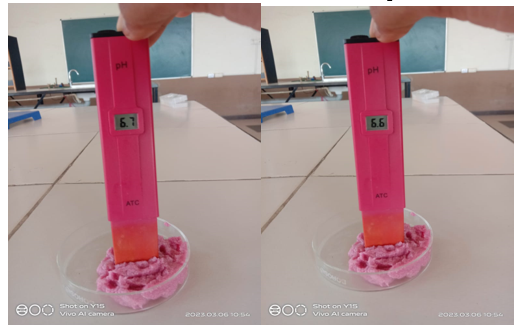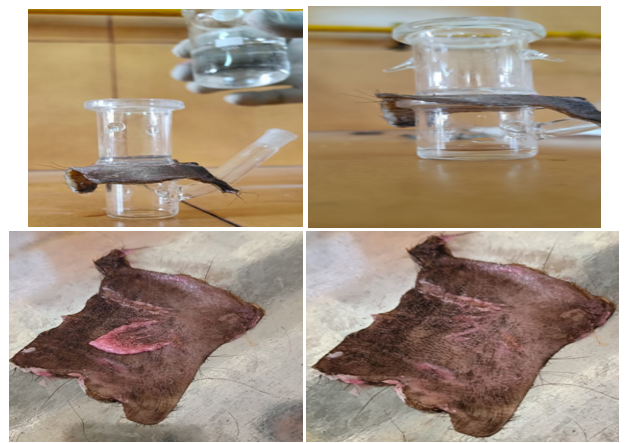Abstract
Early Skin aging is very common and serious aesthetic problem among contemporary population. There can be various reasons responsible for early skin aging, including exposure to UV radiations, oxidative damage to epidermal cells due to poor diet or sedentary life style choices etc. rose hip (fruit) is rich in minerals, tannins, polyphenols, carotenoids and fatty acids as well as vitamin C. these nutrients are very much essential for reducing oxidative stress as well as providing all the necessary elements for skin and dermal cells. Zinc Oxide Along with salicylic acid rose fruit provides a cure to skin problems related topremature anti-aging of cells as well as protection from UV radiations of sun. The aim of this study is to formulate and evaluate an anti-aging cream with the benefits of rose fruit, salicylic acid and Zinc Oxide. The constituents of rose hip and the salicylic acid showed a desirable anti-aging properties by eliminating free radicals and reducing oxidative stress on the other hand Zinc Oxide provides sun screening properties.The cream was then evaluated, the results indicated that the formulated antiaging creams and its ingredients were consistent in quality and can be easily used. From the above results, it is concluded that the formulation containing rose extracts and salicylic acid with Zinc Oxide will be safe and can be used as anti-aging cream on skin.
Keywords
Anti-aging, Rose hip, salicylic acid, cream
Introduction
Aging
Aging is the biological process distinguished bythe collection of damage in structure and decrease in function of cells and tissues over time.Premature aging is a degenerative disease characterized by dry, wrinkled, rough skin and black spots. Two factors trigger premature aging namely internal factors such as stress, endurance, hormonal changes, and health as well as external factors including ultraviolet rays and free radicals. skin is the protective layer of the body of some animal including humans. As the age advances certain changes occur in the skin which are affected by certain extrinsic and intrinsic factors.[1]The Skin undergoes decadent changes as it ages, which include the loss of elasticity, repletion in the epidermal thickness and collagen content, elastic fibre decline, and increased wrinkling and dryness.[2] The facial skin aging isone of the most usual cosmetic concerns to women. The many detectable personification such as wrinkles, sag-ging, uneven skin tone, and dull and dry skin can significantly effects self-esteem and social relations.[3]
Anti-aging agents
Anti-aging agents are those substances that help in slowing down the effects of aging on your skin and body. They can be natural or synthetic, and they work by different mechanisms, such as protecting against cellular damage, boosting collagen production, enhancing hydration, or stimulating cellular renewal. Some examples of anti-aging agents are:
Curcumin:
This is the main active compound in turmeric, a spice that has been used for centuries in traditional medicine. Curcumin has powerful antioxidant and anti-inflammatory properties, which may help delay cellular aging and prevent age-related diseases. It also activatescertainproteins that promote longevity and protect against cellular senescence.[4]
EGCG:
This is a polyphenol compound found in green tea, which is known for its health benefits. EGCG may help slow aging by restoring mitochondrial function, which is the energy production centre of the cell, and inducing autophagy, which is the process of removing damaged cellular material. It also protects against UV radiation and oxidative stress which are major causes of skin aging. [4][5]
Collagen:
This is the most abundant protein in your skin, which gives it structure, elasticity, and firmness. As you age, your collagen production declines, leading to wrinkles, sagging, and loss of volume. Collagen supplements may help replenish your skin’s collagen levels and improve its appearance and texture. collagen can also be found in foods like bone broth gelatine and fish. [4]
CoQ10:
This is a coenzyme that is involved in cellular energy production and antioxidant defence. It also supports the health of your heart, brain, and muscles. As you age, your CoQ10 levels decrease, which may impair your cellular function and increase your risk of disease. Boosted coQ10 levels may protect against cellular aging and oxidative damage. [4][6]
Glycolic acid:
Glycolic acid exfoliates the top layer of your skin, removing dead skin cells and revealing smoother, brighter, and younger-looking skin. It also stimulates collagen production and improves skin hydration. Glycolic acid can help reduce the appearance of fine lines, wrinkles, dark spots, and acne scars. [7]
Rose:
Under the petals of flower, the berry-like fruit is rose hip. It is rich in minerals, vitamins, tannins,polyphenols, carotenoids and fatty acids. In rose hips, the content of vitamin C is higher than citrus fruits it's useful in the anti-aging cream.[8] It shows the strongest anti-oxidative activity as well as anti-skin aging activity such as skin whitening and wrinkle defeat activity[9] it is the most commonly used products for skincare, which works wonders for quenching dry skin and contribution astringent-like effect to help battle acne, redness and inflammation.[10] Besides being filled with antioxidants, rose water and rose powder are also packed with vitamin A and C, which can help with aging skins. Apart from smoothing the appearance of wrinkles, these vitamins help to reduce the look of age spots on the skin and aid with collagen production. While rose essential oil, powder and rose water are derived from rose petals, rose hip seed oil is actually from the small fruits that appear on the rose plants, which are a natural source of retinol.[11]

Fig no 1 Rose Powder
Benefits of anti-aging cream
Anti-aging creams are skin care products thathave various benefits for your skin, especially if you have wrinkles, fine lines, dark spots, or dryness.some of the benefits of using anti-aging creams are:

Fig No 2.Merits Of Anti-Aging Cream
Anti- aging products
Anti-aging creams typically contain either of two core groups of proxy, the antioxidants and the cell regulators. Antioxidants, viz. vitamins, polyphenols and flavonoids, are added into creams to reduce collagen degradation. These compounds quench the free radicals in the tissues, thus keeping their concentrations low. Cell regulators such as retinols, peptides and growth factors, on the other hand, impact collagen metabolism and production. Vitamin A (retinol) containing creams are the most popular on the market, and so are its derivates (retinoid, retinaldehyde and tretinoin). These compounds are capable of reducing expression of mmp 1 (collagenase 1) and beneficially inducing the biosynthesis of collagen. Retinol is the more preferred ingredient over tretinoin in anti-ageing creams, as retinol causes less skin irritation compare to tretinoin (for review see).[12]
MATERIALS AND METHODOLOGY
PROCEDURE

Fig 3.Method Of Formulation
Table 1 Formulation Table for anti-aging cream.

Table 2.Various Formulation Of Anti-Ageing

Formulation:-
Creams usually consist of one or more medicaments in suitable bases.
- Cream Base:-
Creams are formulated using hydrophilic/hydrophobic bases to provide preparations that are essentially miscible with the skin secretion.The base should not produce irritation or sensitisation on the skin, nor should it retard wound healing, it should be smooth, inert, odourless, or almost odourless, physically and chemically stable and compatible with the skin and with incorporated medicaments.
- Additive:-
reams may contain suitable antimicrobial preservative. Creams contain other auxiliary substance like antioxidants, stabilizers, thickeners emulsifiers. If a cream is specifically intended for use on large open wounds or on severely injured skin it should be sterile. Creams should not normally be diluted should dilution be necessary care should be taken to prevent instability and in particular, microbial contamination. Storage: store at temperature below 25°C, unless otherwise directed. (Do not freeze).
Fig. 4. Formulation Of Anti-Ageing Cream'

Evaluation of cream: -
- On evaluation, the creams possessed the appropriate specifications for cream preparations as observed in the organoleptic test. Similarly, the results of the pH measurement also met the specifications for skin pH, as cream preparations must have a pH that matches the pH of the skin in the range of 4.5–6.5.
- Spreadability also affects the nature of the cream when used as a topical preparation because it increases the contact of cream with skin. this ensures easy distribution of active substances.
- The viscosity test results of the three creams according to the specifications for semi-solid preparations are 4000–40,000 cps.
- Furthermore, stickiness is related to the duration of time the cream stays in contact with the skin, and the longer the cream sticks to the skin, the more effective the active substance will be. The results of the three creams showed almost similar stickiness.[13]
- The stability results for the third organoleptic test indicated that the cream was stable because there were no changes in colour odour, or texture.
- For the third pH test, the cream was also stable in the skin pH range, and therefore it is safe to use
- The spreadability of the three formulations increased during storage due to a decrease in the viscosity of the cream. Decreases in fluid resistance to flow increase the spread of cream. The viscosity of the three creams had a similar tendency to decrease, as a decrease in viscosity can occur due to a decrease in emulsion stability over time.
- Another analysis showed that the level of significance was >0.05 for the pH, viscosity, and stickiness, which indicates that storage time has no significant effect on pH, viscosity, or stickiness. The statistical results indicate that the resulting cream formula is quite stable in storage for five weeks.[14]
- Furthermore, the analysis on spreadability showed that there was no significant difference between the weekly variants; however, there was a significant difference in the cream variant, hence, the variation between the o/w and w/o formulas was significantly different.
Antioxidant activity: -
- The oil-in-water cream had better antioxidant activity compared to the water-in-oil type. These results are similar to the results obtained by previous research that stated that carotenoids are more stable in the oil-in-water cream type’ as creams with an anionic emulsifier had better antioxidant activity than those with non-ionic emulsifiers.
- In this study, cream storage was also carried out for five weeks to compare antioxidant activity before and after storage. The results obtained indicated that antioxidant activity decreased during storage.
Physical evaluation: -
- All formulations were evaluated for physical properties including viscosity, homogeneity and grittiness, tests were performed by using small quantity of product.Sample was pressed between the thumb and the index finger and by physical observation. The consistency and the texture of cream were noticed. A small quantity of the sample was rubbed on the skin of the back of the hand to determine the homogeneity and spreadablility.
- Digital pH meter was used to determine the pH of the formulation (cream) by immersing the electrode of pH meter in the samples and the results were recorded. Drug content measurement Assay test was done to sample formulations.
- Rheology
Rheology evaluations were done with “controlled stress rheology & controlled strain rate rheology” methods. By these methods apparent viscosity, consistency parameter, yield stress value, plastic velocity, flow behaviour index etc. were observed.
- Spreadability
Spreadability testing of sample was done using a texture analyser.
Fig.5. Spreadability Test


- pH: -
pH studiedwas done using a physical pH meter. The pH of cream base was found to be in range of 6.2-6.9 which is g
Fig.6. pH test

- Senstivity: -
Sensitivity testing was done by rubbing a small portion of sample on back of the hand.
- Microbial screening: -
Suitable official microbiological methods are used to screen presence of micro - organism aerobic microbial counts. The plate method or multiple tube method is performed to estimate the total microbial count.[15]
- In-vitro drug release (Franz diffusion cell)
With the help of Franz Diffusion, we studied the drug release of anti-aging cream. After cleaning the goat skin thoroughly, the sample cream was applied on it, then we kept it on Franz diffusion cell for some time and observed it 3-4 times to check how much drug was released in it.
Fig. 7 Invitro drug release test

RESULT AND DISCUSSION:
Rosa Canina is well known for its medicinal properties and uses. The rose hip has significant amounts of antiaging constituents such as vitamin C, polyphenols, carotenoids fatty acids and minerals. These constituents help in lowering the oxidative stress and provides a cure for pre mature aging of dermal cells. Antioxidants are very much unstable in nature as they can be oxidised very easily.Therefore, it is very important to ensure their stability and other properties to make them safer for topical use on humans. Rose hip extracts with salicylic acid helps in reducing oxidative stress on dermal cells along with eliminating the free radicals on the other hand Zinc Oxide acts as a sun screening agent in the formulation adding extra benefits top the cream. Evaluation studies showed that the F2 of the 3 prepared formulations was stable and considerably efficient. The physical evaluation tests provided data that reflects the neutral pH(6.2-6.8), desired apparent viscosity, consistency parameter, yield stress value, plastic velocity, flow behaviour index etc of the formulation F2. optimum Spreadability was noticed in F2 formulation with the help of texture analyser. The formulation passed the sensitivity testing as well as microbial screening tests using appropriate methods of testing. Franz diffusion cell was used to study and ensure the in-vitro drug release in the goat skin, all these observations show efficacy and stability of the study on antiaging formulation.
CONCLUSION: -
The results of our study, experimental work, and the evaluation tests showthat the formulation containing rose hip extracts, salicylic acid along with Zinc Oxide is a very effective and safe antiaging cream that can be easily used topically in case of pre mature skin aging due to extrinsic and/or intrinsic factors. This concludes that the presented formulation has a potential to be used as a daily cosmetic product by masses for its antiaging and skin protective properties. Our product could be used to create a market demand and competition among pre existing brands due to its price effectiveness and skin friendly property.
REFRENCES
- Sahu P, Sahu GK, Sharma H, Kaur CD. Formulation, characterization and ex vivo evaluation of epinephrine transdermal patches. Research Journal of Pharmacy and Technology. 2020;13(4):1684-92.
- Sahu P, Mishra S, Sahu GK, Sharma H, Kaur CD. Formulation and Characterization of Resorcinol Gel. Research Journal of Pharmaceutical Dosage Forms and Technology. 2019;11(3):159-63.
- Ali S, Sahu A, Sahu P, Sharma H, Gulati M, Menon SA, Anik S, Sahu GK. A Global Public Health Emergency: COVID-19.
- Sahu P, Mishra S, Sahu GK, Sharma H, Kaur CD. Formulation and Characterization of Resorcinol Peel. Research Journal of Pharmacy and Technology. 2019;12(11):5437-43.
- Sahu P, Bhimte P, Sharma H, kumar Sahu G. A Modern Era Prospective of Novel Drug Delivery System.
- Nagwanshi P, Sahu L, Sahu P, Sahu A, Sharma H, Sahu G. Emphasis of Phytoconstituent in the treatment of cancer. Research Journal of Pharmaceutical Dosage Forms and Technology. 2020;12(3):169-77.
- Sahu L, Nagwanshi P, Sahu P, Sahu A, Sahu G, Sharma H. Novel Approaches of Treatment of Cancer: Nanoparticle. Research Journal of Pharmaceutical Dosage Forms and Technology. 2020;12(2):115-24.
- Sahu P, Sahu GK, Sharma H, Kaur CD. Formulation, characterization and ex vivo evaluation of epinephrine transdermal patches. Research Journal of Pharmacy and Technology. 2020;13(4):1684-92.
- Sahu P, Nema RK. Bioenhancer: an agent for increasing bioavailability. World J Pharm Res. 2021 Apr 1;10(6):613-34.
- Sahu M, Choubey R, Sahu P, Mishra A. A comparative molecular docking study of Syzygium cumini to understand the binding pattern with four different proteins Used for anti–diabetic activity.
- Sahu P, Sahu G, Sharma H, Sahu GK. Preparation and Characterization of Nutraceutical Drink.
- Tandi DY, Sahu P, Sharma H, Nema RK, Sahu GK. Piperine: Physicochemical Aspects for Lung Cancer. International Journal of Biology, Pharmacy and Allied Sciences, January 2023, 12(1): 294-304
- Sahu P, Bhimte P, Singh S, Sarparaj S, Sahu N, Sharma H, Sahu G K. Formulation of polyherbal soap and evaluation of its physic-chemical parameters. Acta Scientific Pharmaceutical Sciences, Vol- 7, Iss 4 (April 2023), 2581-5423
- Sahu P, Yadav S, Bhimte P, Sarparaj S, Sahu N, Sharma H, Sahu G K. Development & Characterization of Vanishing Cream. Acta Scientific Pharmaceutical Sciences, Vol- 7, Iss 4 (May-June 2023), 2581-5423
- Sahu P, Chandravanshi A, Bhuneshwar, Singh S, Sharma H, Sahu G K. Development of Analgesic Chewable gummy tablet for palatable drug delivery. International Journal for Multidisciplinary Research, Vol- 5, Iss 2 (March- April 2023), 2582-2160


 Prerana Sahu* 2
Prerana Sahu* 2
 Ayush Dubey 1
Ayush Dubey 1










 10.5281/zenodo.10932654
10.5281/zenodo.10932654